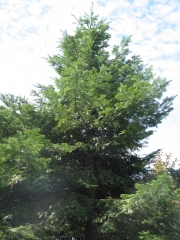
Common Names grand fir
Family Pine
Plant Type Tree
Short Description Intergrades with white fir. Leaves: Needles, singular
Location McCall
Native Yes
Weed No
| Home | Plant List |
 | Abies grandis Common Names grand fir Family Pine Plant Type Tree Short Description Intergrades with white fir. Leaves: Needles, singular Location McCall Native Yes Weed No |
Abies grandis
The Grand fir is a coniferous tree that normally dominates mountainous slopes of elevations averaging from 4875 feet of the Oregon Cascades and up to 6500 feet in South Central Oregon.
The Grand fir forest zone is bounded by an upper zone of Sub alpine fir and a lower zone of Douglas fir or Ponderosa pine. However, that bounding zones may vary due to climates, for instance the higher zones of the Cascade range may be Pacific silver fir, Mountain hemlock or Western hemlock. Also, the Grand fir zone may not have a lower forest of Douglas fir because it may extend into the steppe environment.
Most Grand fir climax zones restart there tree growth with Lodgepole pine and are sometimes dominated by Douglas fir, or Spruce before returning to the climax of Grand fir. Because the Grand fir forest zone is one of the most environmentally tolerant, it is difficult to state the seral stage of the climax Grand fir. Although in most cases after a fire or clearcut logging it will be replenished by seral species of shrub communities which could be; Scouler Willow, Birchleaf spiraea, Snowbrush ceanthus, Serviceberry and there could be more depending on what natures seed banks hold in store for the given region.
Due to the mild environment of the Grand Fir zone it is also the most suitable for mountain meadows. These meadows are usually located at the beginning of water heads. The meadow can be typified as a dense herbatious cover with a perineal grass; usually a type of hair grass (Deschampsia caespitosa). Some of the typical herbatious cover may be Red fectuca (Festuca rubra), Carex spp. (Elk sedge, Hood's sedge, Rose sedge), Parry's rush (Juncus balticus), Showy aster (Aster occidentalis), Snakeweed (Polygonum bistortoides), Trifolium spp. (Longstalk clover, Bighead clover) and Senecio spp. (Western groundsel, Arrowleaf groundsel). Errotioun at the meadow water heads, mostly due to grazing, has become important for both range control and wild life management issues. The Grand fir is a narrowly structured tree reaching up to the heights of 250 ft. with a rounded tip.
The inner bark of the Abies grandes is a dark purplish-red, fading outward through 2-3 inches of smooth bark with a gray or light, ashy brown outer surface.
The rounded buds are at the apex of the stem and usually in groups of 3 with a yellowish-brown appearance.
The leaves (1 to 1.5 in. long) and boughs of the Abies grandes both give the appearance of forming flat mats and slightly reaching upward. The stomatle band is usually found on the lower surface of the leaf, and sometimes a stomatle blotch near the tip on top of the leaf.
The cones of the Abies grandies deteriorate, while still sanding upright on the tree, in early september, dropping there seeds. The 2-4 inch yellowish-green cone does not appear to have a stem, but rather sits right on the branch.
grand fir